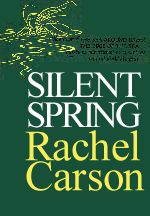Rachel Carson and the Awakening of Environmental Consciousness
Linda Lear, George Washington University
©Linda Lear ©National Humanities Center
|
|
(part 1 of 6)
|
 |
There was a strange stillness. The birds, for example where had they gone? Many people spoke of them, puzzled and disturbed. The feeding stations in the backyards were deserted. The few birds seen anywhere were moribund; they trembled violently and could not fly. It was a spring without voices.
from "A Fable for Tomorrow,"
Silent Spring, 1962
|
|
 |
In the summer of 1962 the prestigious New Yorker magazine published excerpts from a sensational new book by Rachel Carson, America's bestselling science writer and a former marine biologist and editor for the U.S. Fish and Wildlife Service. In Silent Spring Carson argued that humankind was fatally tampering with nature by its reckless misuse of chemical pesticides, particularly the ubiquitous new wonder chemical DDT (dichloro-diphenyl-trichloro-ethane). Writing in a language which everyone could understand and using the public's knowledge of atomic fallout as a reference point, Carson described how chlorinated hydrocarbons and organic phosphorus insecticides silently altered the cellular processes of plants, animals, and possibly humans. In riveting chapters on the contamination of soil, water, vegetation, birds, and wildlife, Carson suggested that the longterm effects of these chemicals were detrimental to the continuation of life. Carson's book warned of a time when bird song would be silenced
 |
 |
Crop dusting, 1972
| National Archives
|
"Can
anyone believe it is possible to lay down such a barrage of poisons on the surface of the earth without making it unfit for all life?"
| Rachel Carson
|
|
|
 |
and spring barren if one species, humans, did not reconsider its careless use of these chemicals. Such arrogance could only end in the destruction of the living world. "Can anyone believe it is possible to lay down such a barrage of poisons on the surface of the earth without making it unfit for
all life?," she asked. "They should not be called `insecticides' but `biocides.'"
|
 |
PhotoDisc
|
"an awakening of public environmental consciousness"
|
|
 |
By the time Silent Spring was published that fall, Carson's alarm had touched off a national debate on the use of chemical pesticides, the responsibility of science, and the limits of technological progress. When Carson died just eighteen months
later in 1964, she had set in motion a course of events which would result in banning the domestic production of DDT by
1972 and create a grassroots movement to ensure the protection of the environment through state and federal regulation.
Most importantly, Carson's writing and her courageous witness helped transform the relationship between humans and
the natural world and led to an awakening of public environmental consciousness.
Lear/Carson Archive  |
Rachel Carson at Woods Hole Biological Laboratory, Massachusetts, 1929
|
|
|
 |
Rachel Carson had always wanted to be a writer. She was born in the small town of Springdale, near Pittsburgh,
Pennsylvania and had loved the natural world since childhood. Fascinated by science in college, she changed her major
from English to biology at a time when women were thought to be intellectually unfit to understand science or have the
physical stamina to be scientists. Carson studied marine biology, received a master's degree at Johns Hopkins University,
and saw the sea for the first time while studying at Woods Hole Marine Biology Laboratory in Massachusetts. Unable to
continue on in graduate school because of the Great Depression, Carson wrote freelance articles about nature and
conservation topics, and finally landed a civil service job as a biologist in 1937. She quickly established
herself as a
writer, rising to editor-in-chief of the U.S. Fish and Wildlife Service by the time she retired in 1952. By then she had
published two highly acclaimed books on the sea. The second, The Sea Around Us (1951), was an international bestseller,
and won the National Book Award as well as other prizes. It made Carson the most trusted voice of public science in
America. A third book, The Edge of the Sea (1955), was equally acclaimed. Carson planned to follow it with other books
about the science of ecology and the intricate relationships that govern the natural world.
TeacherServe Home Page
National Humanities Center
7 Alexander Drive, P.O. Box 12256
Research Triangle Park, North Carolina 27709
Phone: (919) 549-0661 Fax: (919) 990-8535
Revised: June 2002
nationalhumanitiescenter.org |





